Family : Lacertidae

Text © Dr. Luca Tringali

English translation by Mario Beltramini
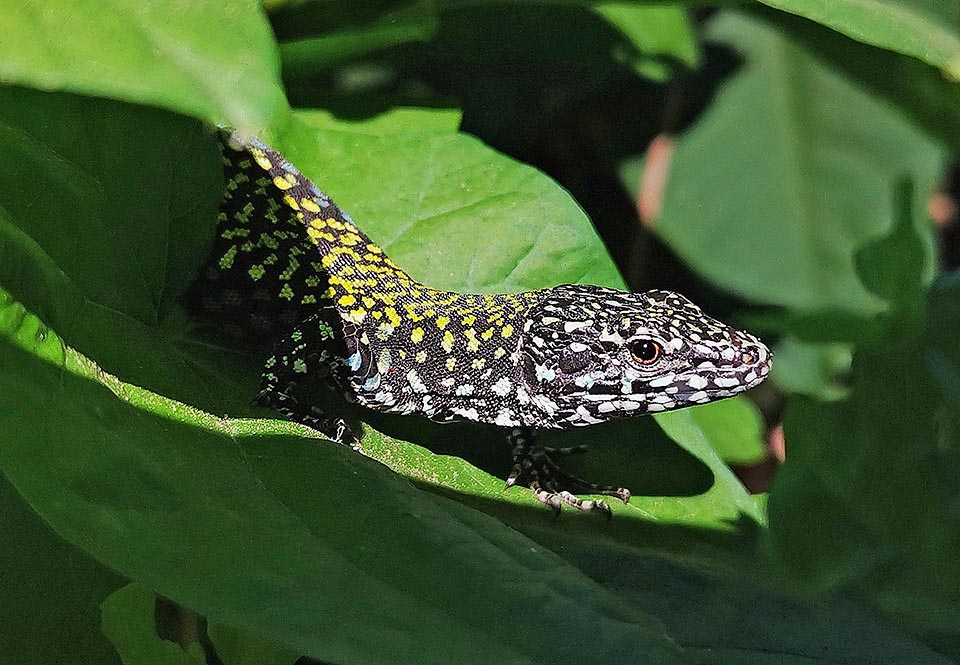
The Common wall lizard is present with 5 subspecies in continental Europe, from France and part of Spain to Turkey. Here a male of Podarcis muralis nigriventris © Cheryl Stinchcomb
The Common wall lizard Podarcis muralis (Laurenti, 1768), is a saurian of the family Lacertidae to which belong 377 species in 45 genera, largely distributed in Africa and in Eurasia. Many Authors, after the most recent biomolecular investigations, in addition to raising up to specific rank several taxa previously considered as subspecies, have divided the family in two subfamilies: Gallotiinae, that include only two genera, and Lacertinae, represented by all other genera.
Most probably the lacertids are native to Europe from where, during the Middle Miocene, 16-14 million years ago (Ma), have invaded Africa and reached the Canary Islands, whilst the diffusion through most of European distribution area dates back to 16-12 Ma, with the appearance of the ancestor of the present small and medium-sized genera.
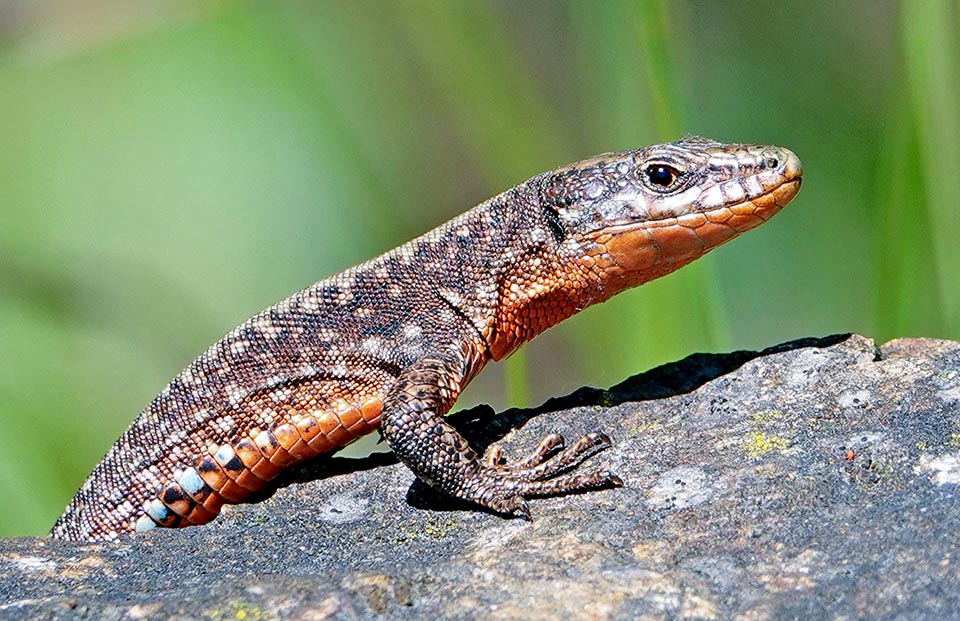
This is the nominal subspecies Podarcis muralis muralis. Now, introduced by man, the species is present also in Canada, U.S.A. and Great Britain © frankielee91
The subsequent colonization towards Asia took place most recently, about 10 Ma.
Podarcis muralis gets its generic name from the Greek “ποδαρκής” (podarkís), fast foot, to indicate the extreme speed of these lizards, whilst the specific epithet muralis (from Latin) is reflected in the common name of the Common wall lizard and refers to to one of the choice environments of this reptile, as the original description states as furnished by the Austrian naturalist Josephus Nicolaus Laurenti in 1768: “habitat in maenibus, ruderibus, aggeribus, lapidosis passim ubique” (lives everywhere in the walls, in the ruins, in the embankments and in the stony sites).
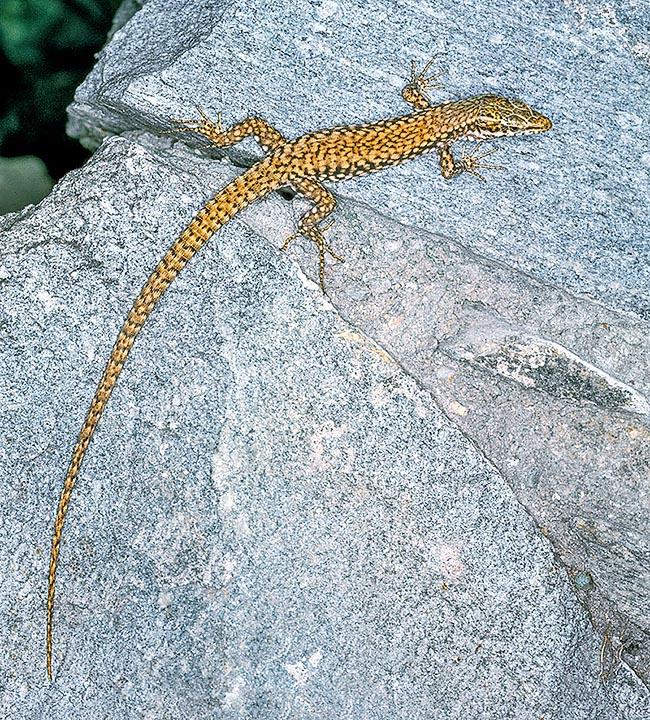
Podarcis muralis brongniardii is the subspecies present in north-western Spain, in France and in the Netherlands © Giuseppe Mazza
Zoogeography
It is hypothesized that the origin of the genus Podarcis may have taken place during the Oligocene, 33,9 Ma, whilst the diversification in the current species has begun later, during the Miocene.
At present they are attributed to this genus 27 species of which Podarcis muralis presents the largest geographic distribution.
The Common wall lizard displays a complex zoogeography, with origin in the central Mediterranean portion of its present range of distribution, area presently occupied by the Italian Peninsula, and, more precisely, in Calabria.
Its first expansion occurred towards the Iberian Peninsula westwards and towards the Balkans eastwards, and continued its diffusion towards central Europe.
Following the isolation in some shelters, many in Italy and one in the Pyrenees, caused by the most extended Pleistocene glaciation, the Elester glaciation of 480.000 years ago, Podarcis muralis recolonized Europe along the Atlantic coast and along the river systems of the Rhone, of the Rhine and of the Moselle, assuming the current geographic distribution.
This species is present in continental Europe, from Italy, Spain, southern Balkans and Asia Minor up to the Netherlands and to the central-south-western Germany.
Its distribution in the northernmost areas of Europe is mainly restricted to isolated populations, often introduced.
Recent introductions made by man, moreover, have notably enlarged the range of this species who has settled in Canada, in the U.S.A. and in Great Britain, where presently live at least 150 non-native populations.
The remarkable morphometric variability, of the number of scales and of the colour of the body of Podarcis muralis has led, in the past, to the proliferation of several subspecies described on a morphological basis, whose validity has been periodically contested.
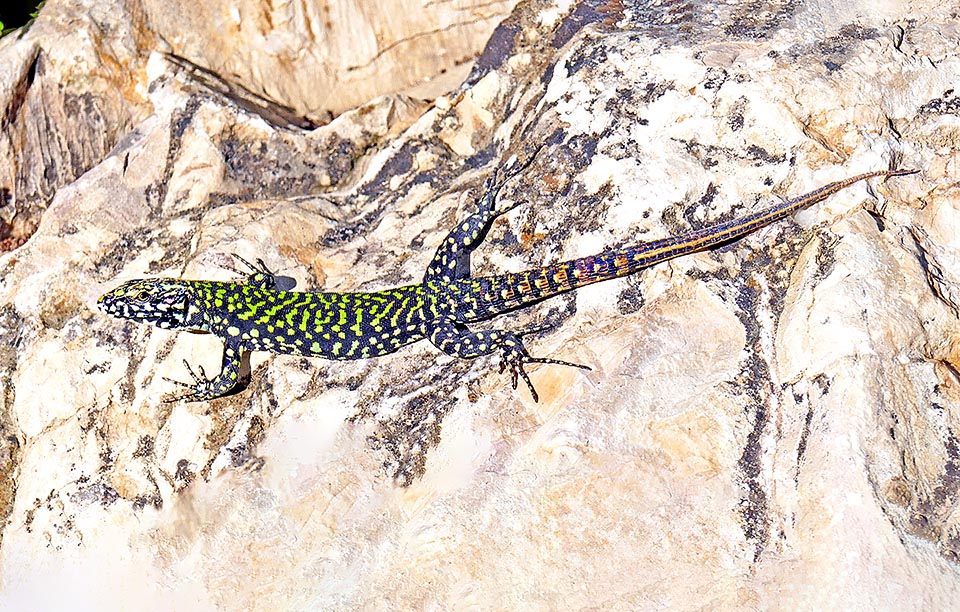
Male of Podarcis muralis nigriventris. This subspecies is frequent in central and northern Italy © Luca Tringali
Despite the progress and the results obtained by the most phylogeographic and phylogenetic research, the subspecific set-up of the Common wall lizard still remains to be clarified, especially for what concerns the populations that have colonized the Tuscan Archipelago.
According to the current state of knowledge might be valid at least five subspecies:
the nominal subspecies Podarcis muralis muralis (Laurenti, 1768), of central-eastern Europe, Balkans and Turkey.
Podarcis muralis brongniardii (Daudin, 1802), distributed in north-western Spain, France, Netherlands.
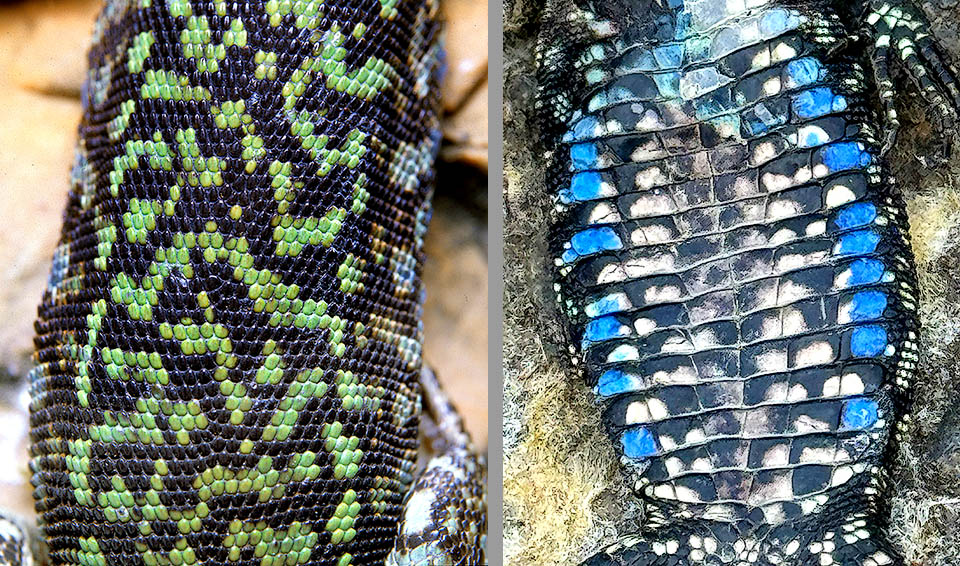
Its characteristic dorsal drawing is reticulated and the belly displays on the sides bright turquoise spots. © Giuseppe Mazza (left) and © astonishingnature (right)
Podarcis muralis breviceps (Boulenger, 1905), Calabria and Gargano Apulia.
Podarcis muralis maculiventris (Werner, 1891), in northern Italy, western Austria, southern Germany, southern Switzerland, western Slovenia, northern Croatia, Romania, Great Britain, U.S.A., Canada.
Podarcis muralis nigriventris Bonaparte, 1838, present in central and northern Italy.
To these we might add three subspecies of the Tuscan Archipelago, one of the Tinetto Island (Ligurua) and one of Santo Stefano Island (Lazio), of still uncertain validity. Also the validity of the subspecies Podarcis muralis albanica (Bolkay, 1919) is still to be confirmed.
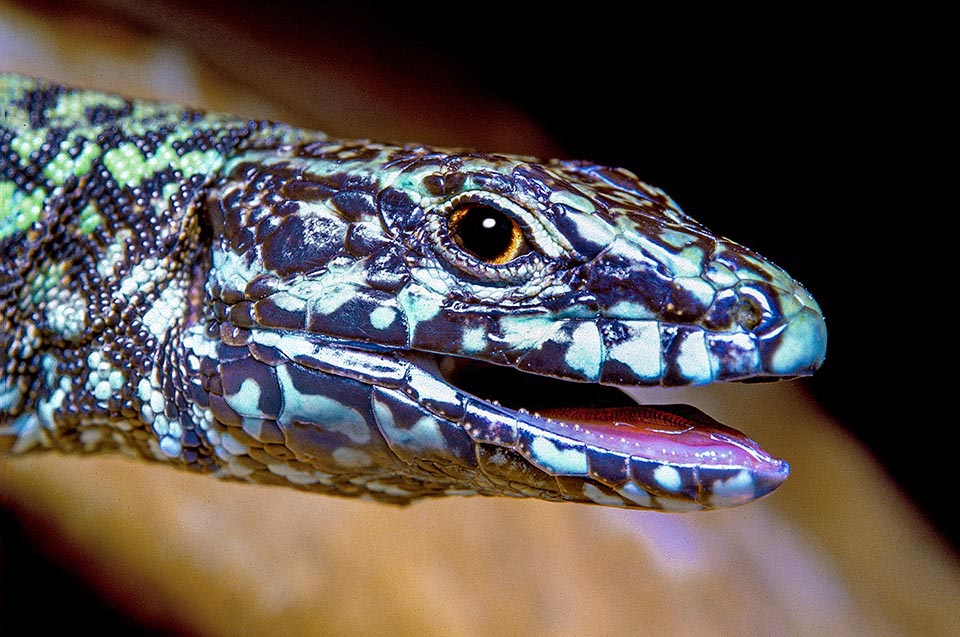
In the largest males Podarcis muralis reaches the length of 23 cm. The tiny teeth are not used for chewing but for holding the preys © Giuseppe Mazza
Ecology-Habitat
Podarcis muralis is present in a huge variety of environments, whether natural or artificial, and among the European lizards is the one who most frequents the urban areas.
In the northern regions the species is distributed uniformly from the sea level up to more than 2000 m, and is practically ubiquitous, frequenting both open and covered spaces by vegetation, preferably in drier habitats at the higher altitudes.
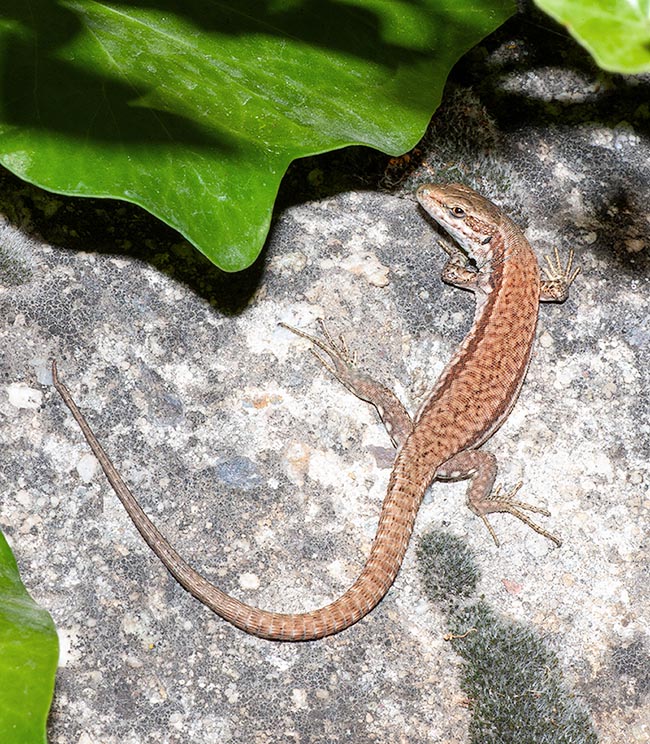
It is active only when the body temperature reaches 32-36 °C and therefore must often thermoregulate in the sun © Giuseppe Mazza
Conversely, in the southernmost distribution area it presents mainly hill and mountain habits, where it frequents zones wetter and sheltered from the sun.
It prefers habitats characterized by the presence of vertical surfaces with rocky faces, walls, trees, that are utilized for the thermoregulation, that is the capacity of regulating the body temperature, due to the copresence of sunny zones and in the shade.
Moreover, these elevated environments are ideal for the scan behaviour, as shelter thanks to the presence of cracks and cavities, and for predation.
Podarcis muralis is a rather thermophilic species, with a body temperature of 32-36 °C, and with an activity period highly influenced by the climatic conditions that occurs from February-March up to October-November, often longer in the males.
Also in winter, when the climate conditions are favourable, it is possible to observe young individuals and adult males active outside.
The day activity during the spring and autumn months is almost continuous, whilst in summer it manifests in bimodal manner, as are reported some interruptions during the warmest hours, with the exposition to the sun for the thermoregulation occurring during the first hours of the morning, and subsequent predation activities.
Podarcis muralis is a generalist and opportunistic reptile as its food spectrum is determined mainly by the resources available in the habitat it occupies.
Essentially insectivorous, this lizard preys upon a vast range of terrestrial invertebrates without displaying evident preferences of specific systematic groups, even if the central nucleus of its diet is usually formed by Araneae, Coleoptera, Hemiptera, Heteroptera and Hymenoptera.
Podarcis muralis adopts an active style of predation, but may, occasionally, hunt in ambush.
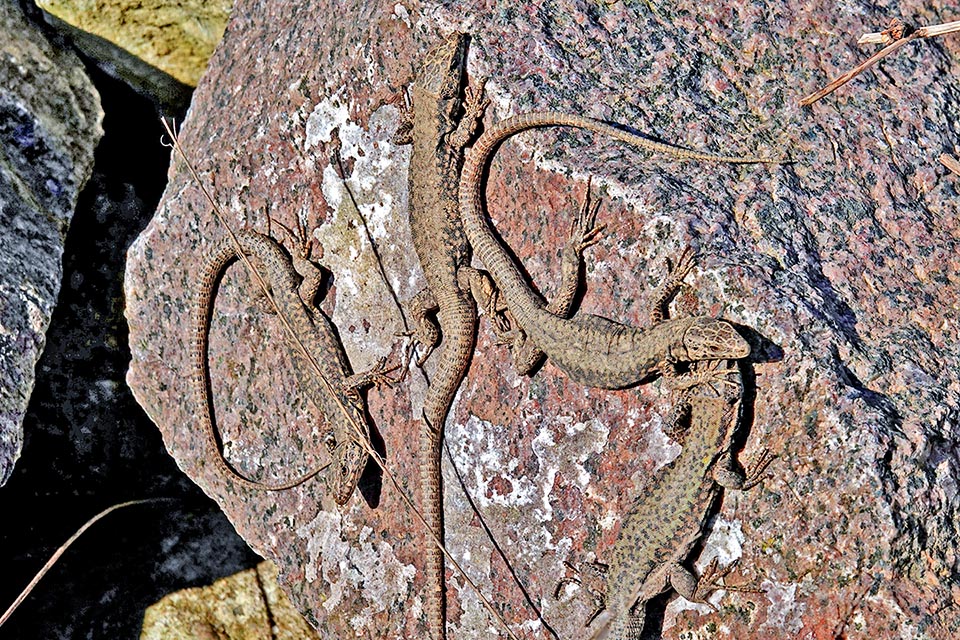
Where winter is harsh the Common wall lizard hides and hibernates. Here upon awakening a group warming in the sun © frankielee91
Like in other species of the genus Podarcis, in the Common wall lizard have been observed instances of saurophagy and of cannibalism.
Furthermore, rare cases have been of ingestion of one’s own tail and of the skin in moult.
Having to regulate its own body temperature through exposure to the sun, Podarcis muralis is particularly subject to attacks during these prolonged stays.
Among its predators we count mantises, reptiles, birds and mammals.
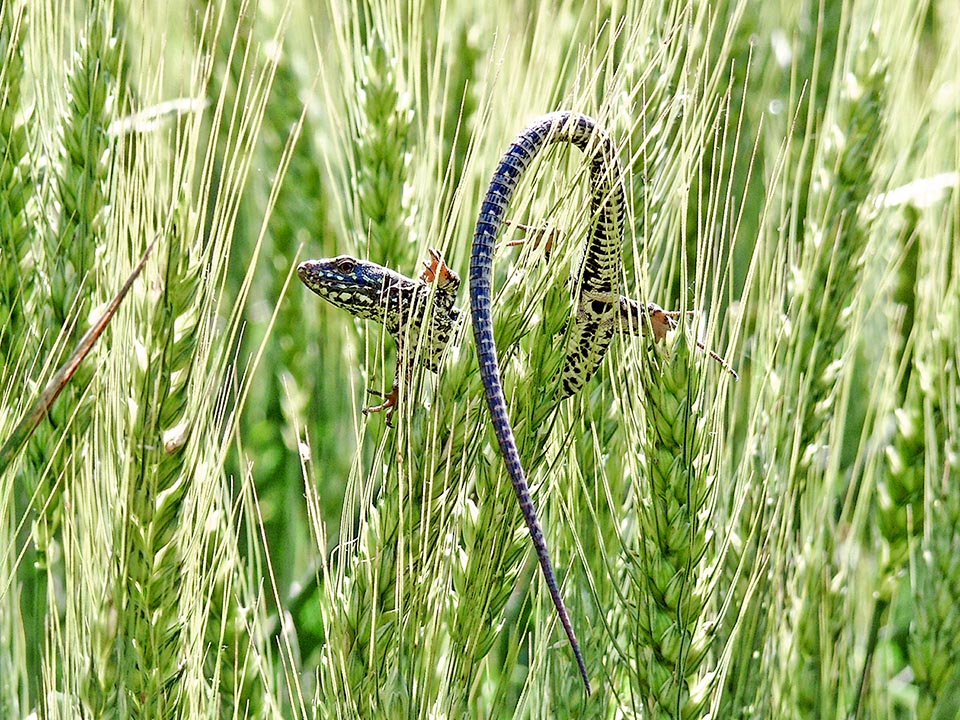
Podarcis muralis adopts an active predation style, but occasionally camouflages to hunt in ambush © Luca Tringali
Its anti-predator behaviours are essentially two, often combined: the escape, being a particular rapid animal, and the autotomy of the tail, from the Greek “αυτός” (autós) = itself and “τέμνω” (témno), cut.
The capacity of losing the tail and of regenerating it is a defense strategy that in the lacertids has acquired a high evolutionary level.
At the level of the caudal vertebrae are present some breaking points predetermined so that these reptiles may voluntarily produce the detachment of the tail, or parts of it, in presence of predators and when they are in danger, leaving the not vital part to distract the predator and allowing the lizard to escape.
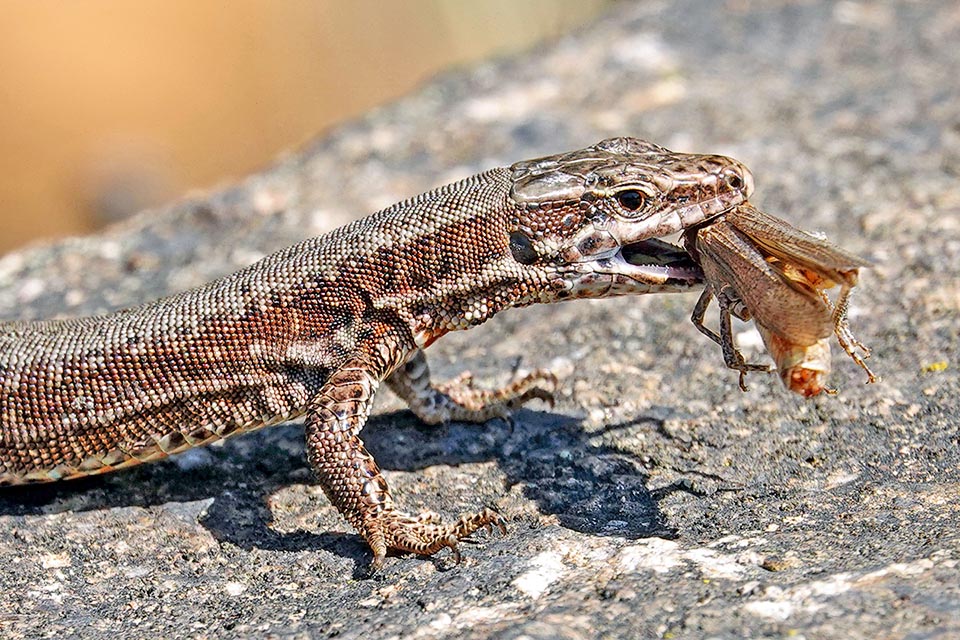
Essentially insectivorous, this lizard preys a wide variety of terrestrial invertebrates like this grasshopper © frankielee91
The regeneration process will subsequently lead to the formation of a new appendix, external not too much different from the original one, but quite modified from the muscular, nervous and skeletal point of view. Especially, the original vertebrae are replaced by an empty cartilaginous structure, and even the spinal ganglia, containing sensory nerve cells, are not regenerated.
It is important to note how the autotomy of the tail occurs only in particular situations of serious danger as its loss reduces the mobility of the animal, its reproductive capacity and its social status.
Within the anti-predatory characteristics we can also cite the capacity of the Common wall lizard of distinguishing the smell of a saurophagous snake from a harmless reptile, and consequently to avoid to share the den of the dangerous subject.
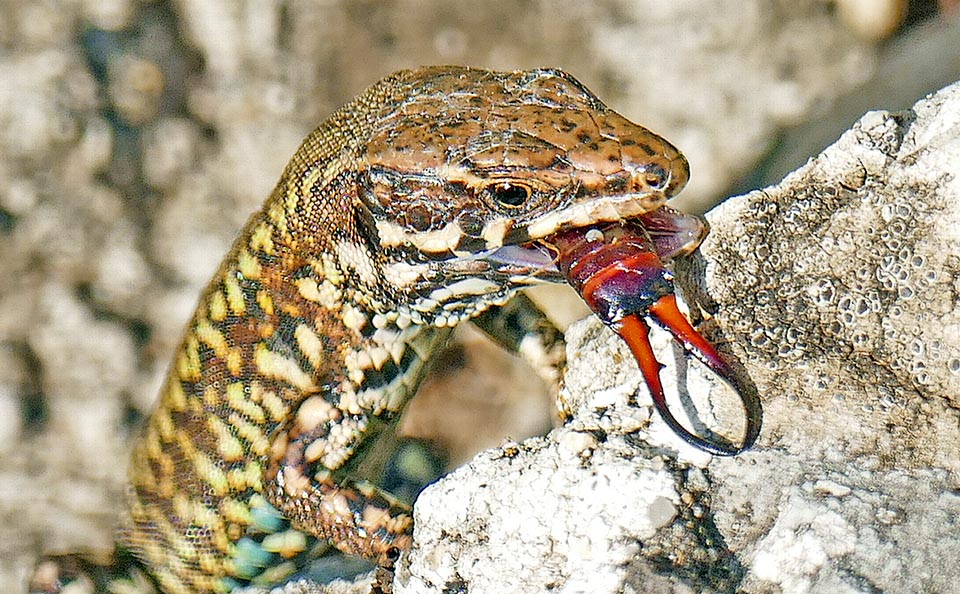
Here it has seized a Earwig (Forficula auricularia) and doesn’t show clear preferences for precise systematic groups © Luca Tringali
Morphophysiology
Podarcis muralis is a medium-small sized lizard, slender and flattened; the average length of the adult males, usually bigger than the females, is 160-230 mm. In proportion to the body the limbs are long and the head is wide; both sexes, moreover, display a quite evident collar formed by 7-17 scales.
The colour of the body is extremely variable, among different populations as well as within the same population: the chromatic polymorphism manifests through colours of the back that may be brownish, greyish or greenish.
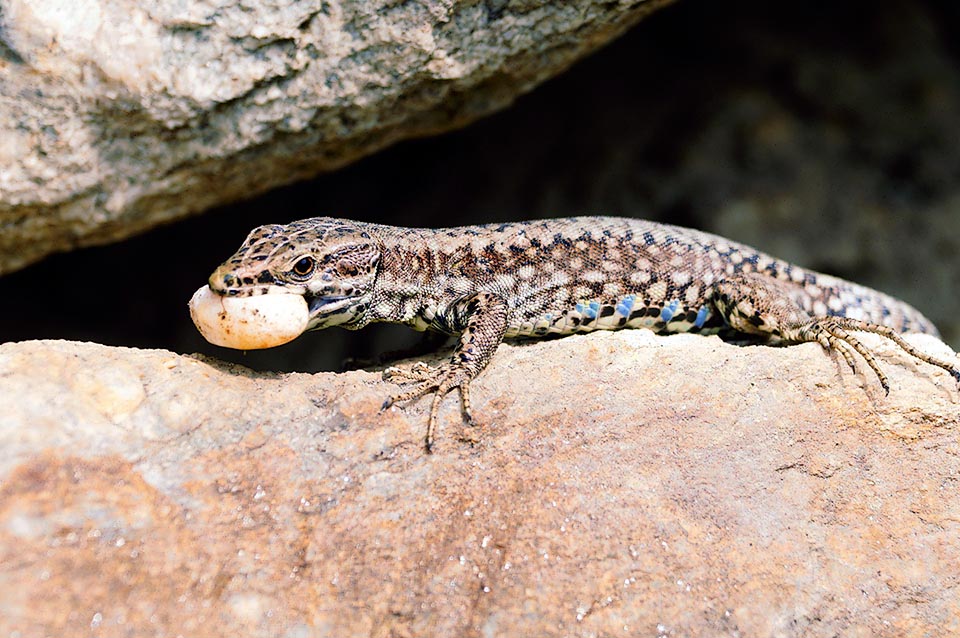
Podarcis muralis is a generalist and opportunist reptile who doesn’t hesitate not even in front the just laid eggs in a nest of its own species © Corinna Herr
In the individuals with brown dorsal colour, the sides are run by two clear stripes that enclose a darker longitudinal band, often reticulated in the males and more homogeneous in the females.
In the greenish individuals, the bands, often missing, are replaced by bright spots of yellow-green colour and by a black, more or less dense, reticulation.
Furthermore, the Common wall lizard presents three main types of dorsal ornamentation that includes a linear morph with a more or less continuous dark vertebral stripe, a reticulated morph where the the vertebral stripe is replaced by a reticulated drawing, and an intermediate morph where the reticulated drawing forms a more or less continuous vertebral stripe.
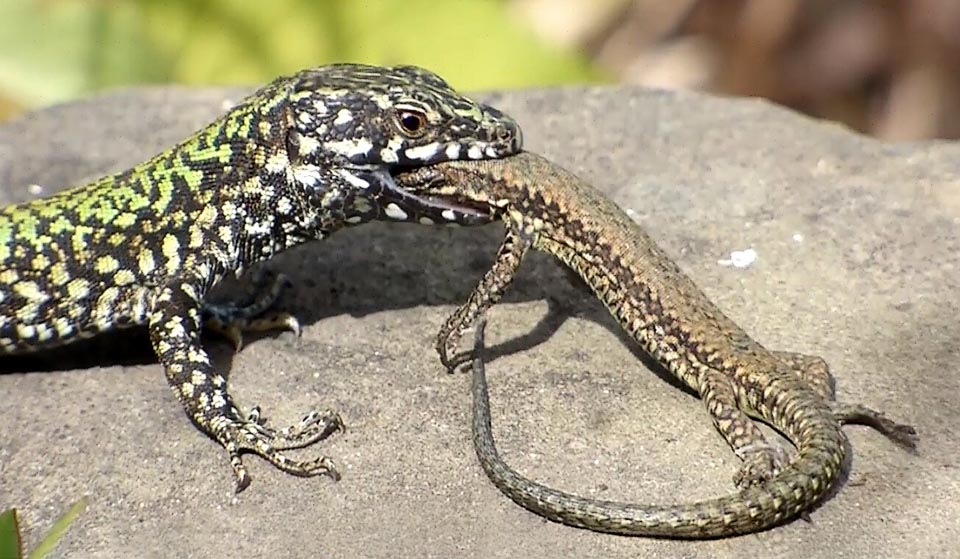
And there are gruesome cases of cannibalism, like for this poor juvenile who was in the wrong place © gavinh
There is a strong correlation in the geographic distribution of the dorsal ornamentations that confirms the origin in the Italian Peninsula of Podarcis muralis, as central Italy is the only area where the three morphs are equally distributed, whilst in the other European countries the linear morph tends to prevail.
It has not yet been clarified if the sexual polymorphism of this species is correlated to advantages in the thermoregulation in different climate conditions, to a certain degree of protection from the ultraviolet rays, to the sexual selection, to the cryptism linked to different environments, to the evolutionary history of the species itself, or to whole such hypotheses.
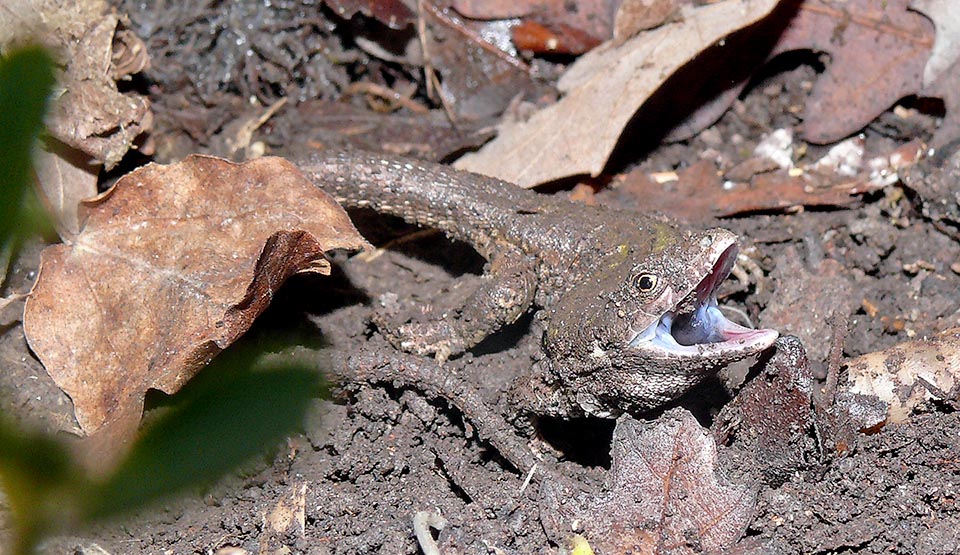
Podarcis muralis is highly territorial. Males control an area overlapping that of one or more females and defend it by biting against the intrusion of other males © Luca Tringal
For what the ventral polymorphism concerns, Podarcis muralis presents, also, six main chromatic morphs: three pure (white, yellow and red), and three intermediate (white-yellow, white-red, yellow-red). The females differ from the males as having the dark sides, the clear dorsolateral stripes, the vertebral stripe missing or accompanied by dark dots, shorter hind legs and smaller head; the males have a reticulated drawing, sides often dotted with clear and bigger size.
Generally, the individuals of the populations of cooler climates and of high altitudes grow more slowly than those loving in the warmer areas, characteristic that allows them to live longer: research done on populations of Turkey have shown a greater longevity, up to 16 years, in individuals of high altitudes, compared to populations of low altitude that reach a maximum longevity of 14 years.
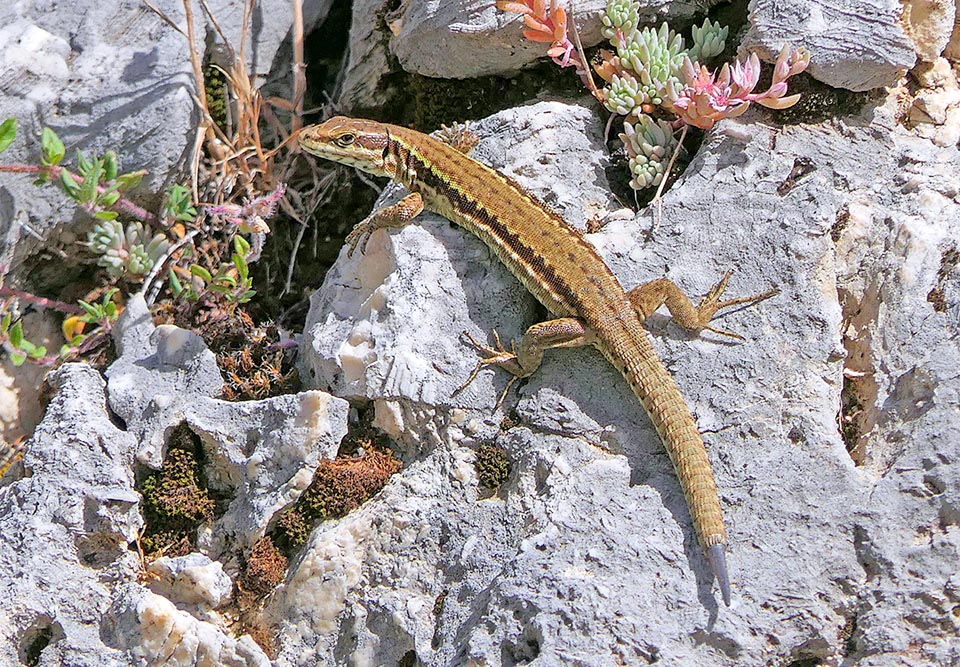
So it is normal that someone loses its tail that breaks in pre-established points then shaking on the ground to distract the attacker © Luca Tringa
Ethology-Reproductive Biology
Oviparous species laying eggs several times a year, Podarcis muralis reaches sexual maturity when two-three years old and presents a reproductive season from March to June, depending on the latitude, the altitude and the local climatic variations.
Up to three annual reproductive events may take place, on a monthly basis, but the number of the lays seems to be mainly related to the age of the females: the higher the age, the greater will be the number of layings during the same year.
Each brood is formed by 2-10 eggs laid preferably inside small dens dug in loose soils.
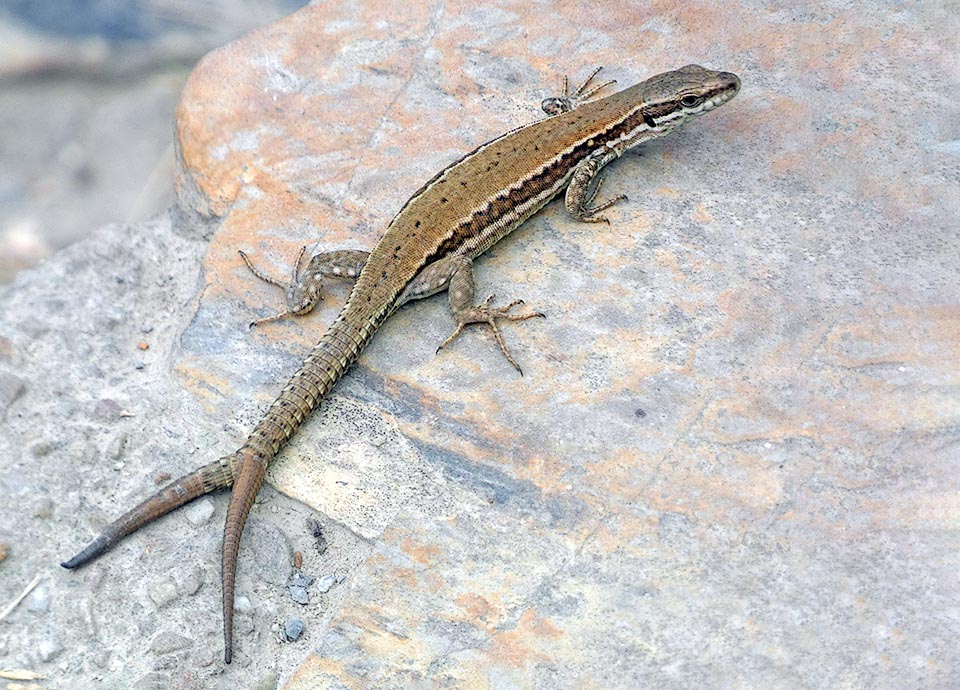
This then regrows, at times even bifid, but this reduces the mobility of the animal, and its reproductive capacity and the social status © Jacobo Krauel
The hatching takes place after 9-11 weeks and the young individuals born from eggs incubated at relatively low temperatures, around 28 °C, are on average larger and faster. Moreover, there have been observed cases of common broods relating to multiple females, when nests are scarce presenting optimal conditions for the deposition.
Podarcis muralis is a highly territorial species and the adults of both sexes occupy and defend their own territories particularly during the reproductive season.
The juveniles and the adults who do not occupy their own territory live in a condition of continuous mobility in non optimal environments on the margins of the resident populations.
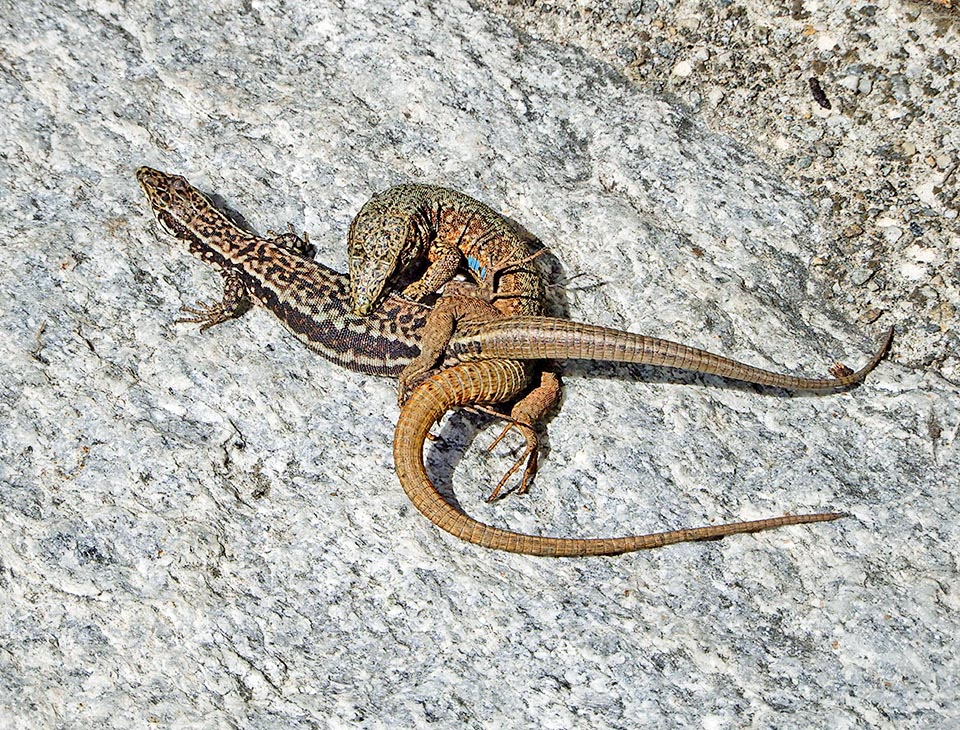
For mating the male blocks the female biting her on the side while it fecundates her with one of his two hemipenes © Giuliana Pirotta
The size of the territory varies between 6 and 50 square metres, is bigger for the males and is correlated with their body size: the bigger is the size of the male, the greater will be the extension of the territory it controls and bigger will be the number of females living there.
Podarcis muralis displays a polygynandrous reproductive system (from the Greek “πολύς” (polús), much, “γυνή” (giné) woman, “ἀνήρ”(anér), man), where the males as well as the females do mate with multiple membres of the opposite sex.
The males control an area that typically overlaps with the territory of one or more females, and defend it aggressively against the intrusion of other males. They are able to perceive, decode and utilize the information coming from the femoral secretions, relative to the size and the social status of the opponents, modulating accordingly the behaviours of attention and of aggression.
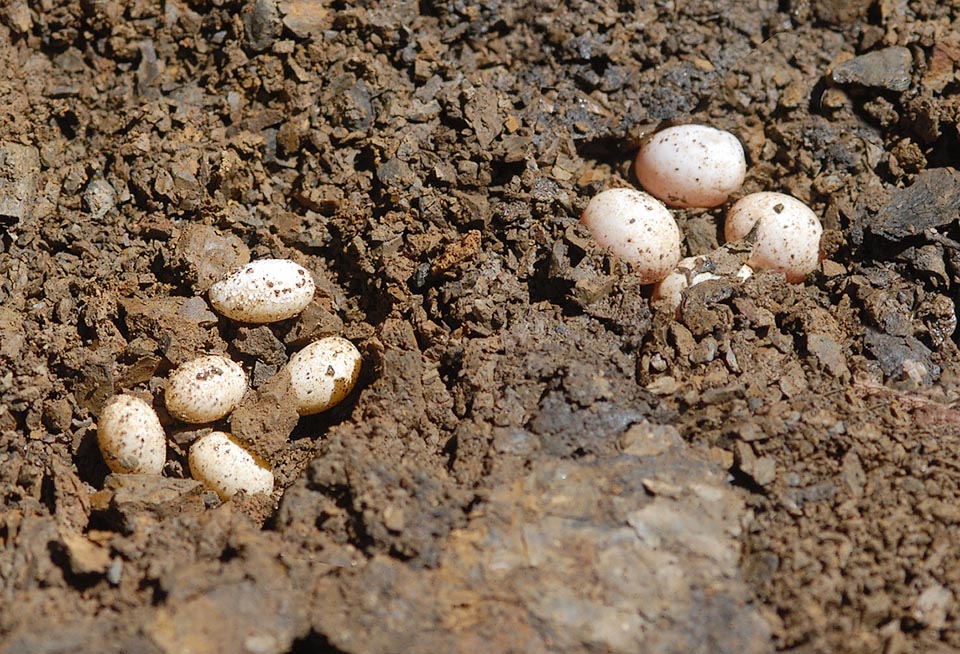
Two nests placed in the open. Every brood is formed by 2-10 eggs that hatch releasing autonomous babies after 9-11 weeks © Philippe Geniez
Moreover, they manifest similar aggressiveness while courting, when they try to block the female by biting her on the side while they insert one of the two hemipenes.
It is still under discussion the hypothesis of the sexual choice on the part of the females, based on olfactive stimuli produced by the femoral glands of the males, or if prevail the visual stimuli in relation of the different ventral morphs, or is exists a certain type of interaction between the two stimuli.
A further hypothesis concerns the non-choice on the part of the females who would not have an active rôle while looking for the male, and that they would be, conversely, “passive partners”.
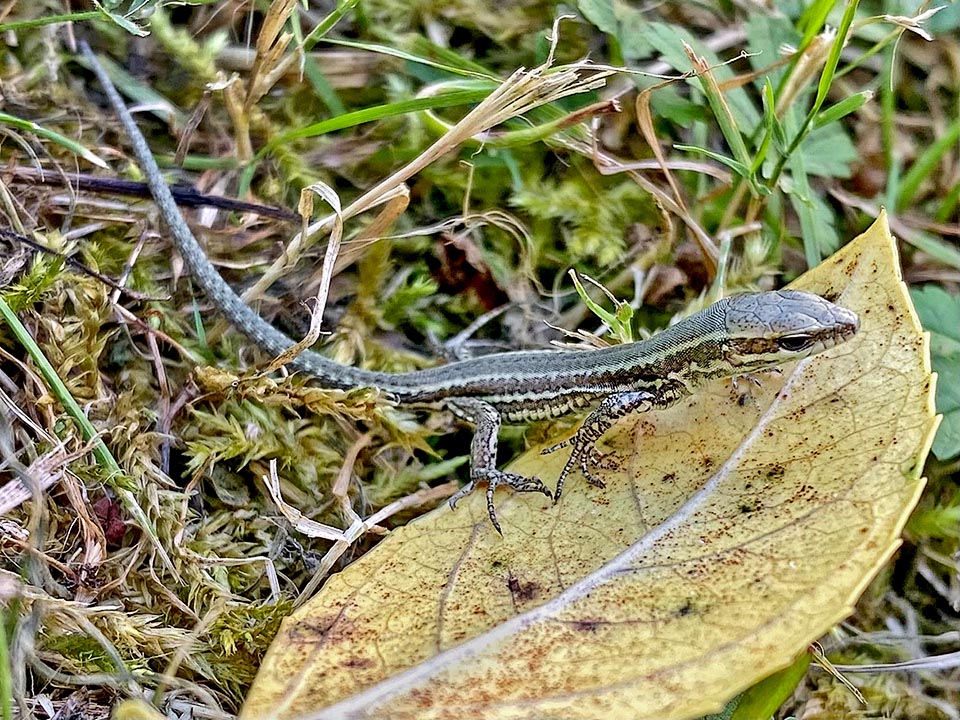
Young growing up. We note several horizontal camouflaging streaks that recall the dark ones of the females © chachoulette
Field observations suggest, rather, that the ventral polymorphism of the females is correlated to the reproductive strategies, as females with yellow belly should lay many small eggs, and females with white belly would opt for smaller broods but with bigger eggs, both regardless of age; those with the red belly, conversely, would adopt a mixed reproductive strategy in relation to the age: few eggs but big when younger, and later on small numerous eggs.
Podarcis muralis is classified “LC, Least Concern” in the IUCN Red List of the endangered species as it is no in obvious danger thanks to its capacity of adapting to different environments, even in very distant geographic areas from its natural distribution range where it is able to settle with stable populations.
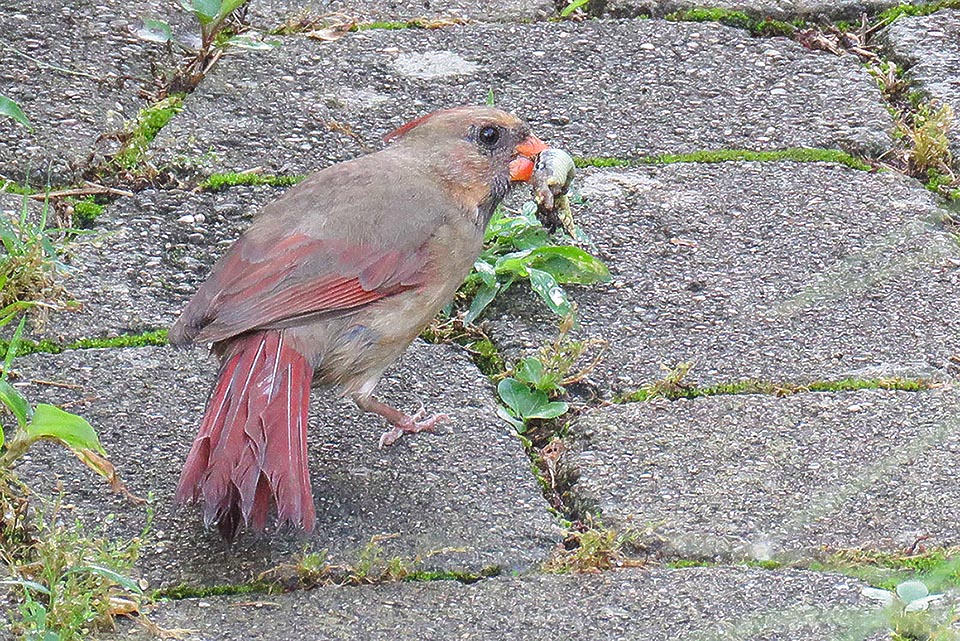
Podarcis muralis is often preyed upon by snakes, though it avoids saurophagis sensing their smell, but also by small mammals and birds like this Cardinalis cardinalis © William Hull
The fact that Podarcis muralis is a highly invasive species is proved by the diffusion of this species in the U.S.A. where, voluntarily introduced in Ohio, boasts at present well-structured populations in California, Kansas, New Jersey, New York and, probably, in Missouri.
Nevertheless, the environmental changes affecting the habitats and the increase in the agricultural activities may form limiting elements for the presence of the Common wall lizard in certain locations, particularly in the islands.
Synonyms
Seps muralis Laurenti, 1768; Lacertus terrestris Garsault, 1764; Lacerta maculata Daudin, 1802; Lacerta muralis Sonnini & Latreille, 1802; Lacerta fasciata Risso, 1826; Lacerta porphyria Dehne, 1856; Podarcis muralis Boulenger, 1920.
→ To appreciate the biodiversity within the LIZARDS please click here.
